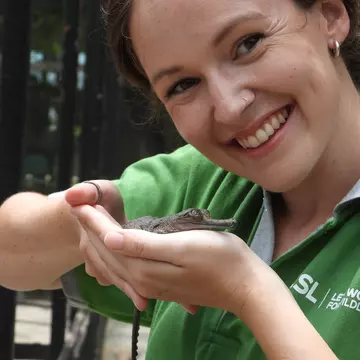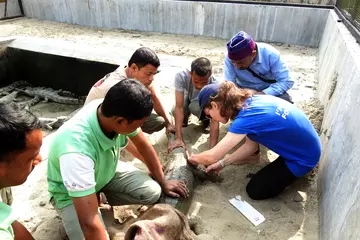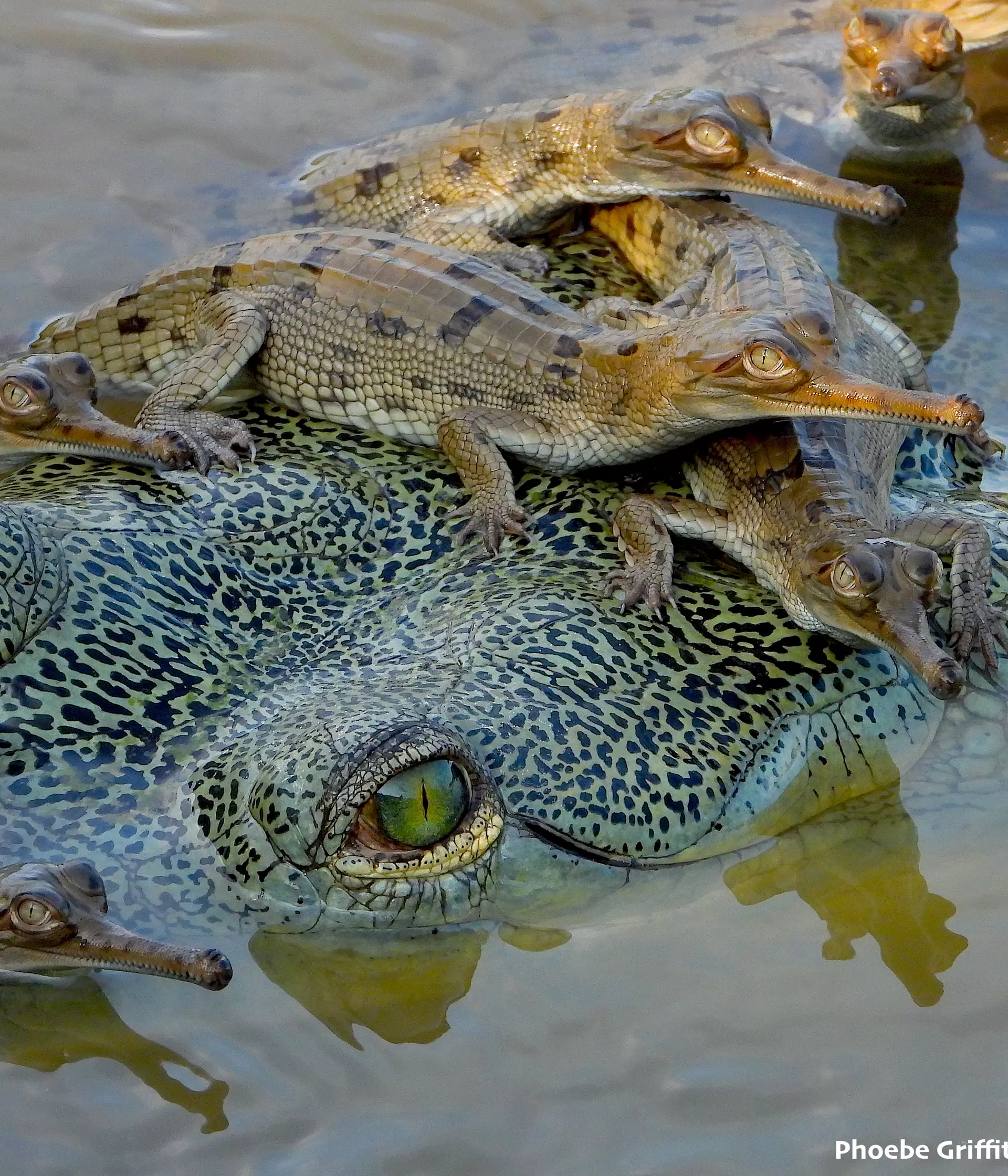
Why hope is just around the river bend for Nepal's next generation of gharial.
We talk to Phoebe Griffith, PhD student at ZSL’s Institute of Zoology, to find out how new research is helping these rare, river-dwelling reptiles in Nepal – and why ‘head-starting’ is no substitute for hard-earned survival skills.

For anyone who’s never encountered one of these animals before, how would you describe a gharial?
With their long, crocodile-like bodies and thin snouts containing over 100 razor-sharp teeth, some may be surprised that gharial are actually shy pescatarians (mostly, with the odd crunch on a turtle). They’ve been on our planet for over 40 million years but are perilously close to extinction, with only tiny populations remaining in the rivers of Northern India and Nepal.

Is there anything else that’s interesting or unusual about them?
Gharial are incredible parents – and step-parents, too! The females lay their nests communally and the babies hatch together – sometimes hundreds of them, or even a thousand.
An adult female, or a male and female, then guard the whole creche from predators such as birds, fish or turtles. During this period, males communicate with their babies and other gharial, using the distinctive ‘pop’ sound that only they can produce.
The size difference between adult males – sometimes reaching over 6 meters – and their tiny 30cm babies is staggering, the babies have a habit of sitting on the adults’ heads!

What are the main threats to their survival?
Rivers are some of the most threatened ecosystems on earth. As with other freshwater species, the main dangers to gharial are habitat fragmentation, riverbank development, water extraction and pollution.
Sand mining is another major issue. Sand is being rampantly and unsustainably extracted from rivers across South Asia – destroying the sand banks gharial need for nesting and basking, as well as the spawning beds for the fish they feed on.
Gharial are also often washed down through dams, and easily entangled in modern gill nets, leading to them either drowning or being killed so the nets can be recovered.

How have conservation efforts been going so far?
Until recently, efforts have focused on ‘head-starting’ gharial in captivity, getting them to a predator-proof size, and then releasing them into the wild. Unfortunately, this strategy rarely seemed to work.
Thanks to our five-year research project, tagging ‘head-started’ gharial and those born in the wild, we now understand why. Gharial born in captivity are especially susceptible to threats, particularly getting caught in gill nets. They also appear to have a high risk of being killed by a predator, since they have never seen one before!
Is there any good news?
Yes! The study has shown us that adult gharial have really high survival rates in Chitwan, South Nepal, and are regularly nesting in the wild. Those babies are also surviving, which is fantastic. This suggests that a shift to protecting nesting habitat and removing human threats, especially gill net fishing, could lead to population recovery in the very near future.
ZSL Nepal have been busy working on the conservation action side of this research, reducing threats and empowering communities to move away from a reliance on fishing in the river, through our alternative livelihoods programme.

Can you tell us about your best moment on the job?
In 2019, we travelled deep into Chitwan National Park to see if the nests in the wild had hatched successfully – the first experiment of its kind for over 40 years. Our team of three stopped the traditional wooden canoe upstream and walked down to the shore on foot. We heard a tiny peeping sound, and then there they were – dozens of baby gharial sitting on mum’s head, swimming in the water around her, and sunbathing on the shore. The eggshells on the bank showed that over 100 hatchlings had emerged.
Since then, we’ve documented a surprisingly large number of these babies surviving their first few years to become too big for most predators, and well on their way to becoming huge adults.

What inspired you to get involved in this project?
I did a Masters at ZSL and was volunteering at the London Zoo Reptile House at weekends. I was immediately interested when I heard about this project, because I grew up in Nepal and visited the gharial breeding centre as a child. I’ve never looked back!
What are your hopes for the future?
My wish is for there to be healthy, self-sustaining gharial populations throughout the Ganges Basin – and also in the Brahmaputra and Indus rivers, where the species is currently extinct. Gharial have disappeared from over 94% of their former range, and although it will never be possible to see them everywhere again, it would be wonderful to see them return to stretches of the river.
Seeing a young gharial on a riverbank is a good sign for people and wildlife. It means that resources are being extracted sustainably, and the river is able to fulfil the needs of the people who live alongside it and the biodiversity within it. That’s what we’re working to achieve.
